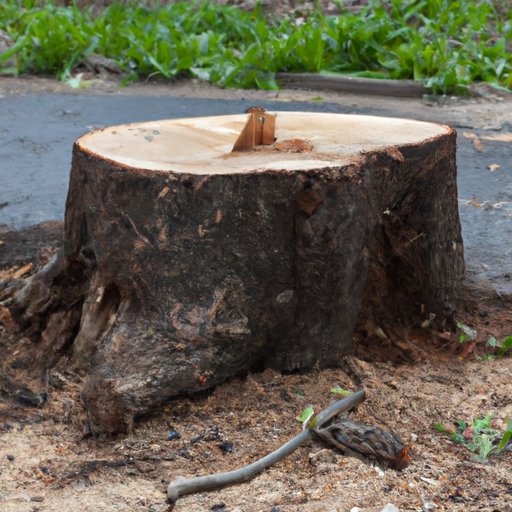
I. Introduction
Tree stumps are a common problem in residential and commercial properties. Not only are they unsightly, but they can also pose a safety hazard. A tree stump can cause tripping, attract pests, and can make it difficult to perform lawn maintenance. This article aims to provide a comprehensive guide for removing tree stumps on your own, including necessary tools, safety precautions, and DIY versus professional help.
II. Assessing the Tree Stump
Before attempting to remove a tree stump, it’s essential to assess its size, age, and condition. A larger and older stump may require more effort and specific tools for its removal while a smaller one may be easier to handle. Assessing the condition of the stump’s roots will also determine the tools and technique to use. Check the soil around the stump to see if the roots have rotted, or if they are still strong and healthy. This will affect the ease or difficulty of removing the stump.
III. Tools Required
Effective stump removal requires the use of specific tools. These tools include a chainsaw, spade, ax, digging bar, and stump grinder or rental equipment like a backhoe or skid steer with a bucket or grubber attachment. Before using these tools, it’s essential to follow manufacturer instructions on how to use and maintain them. Protective gear like gloves, goggles, ear protection, and hard hats should also be used while working with these tools.
IV. Remove Tree Stump – Step by Step
The following are steps to remove a tree stump:
Step 1: Clear the Work Area
It’s essential to clear the area around the stump to create space for the tools and equipment required to remove it. The area should also be free of any obstacles that can interfere with the removal process.
Step 2: Cut the Stump Using a Chainsaw
Starting at the base of the trunk, make a horizontal cut using a chainsaw 3-4 inches above the ground. This can be repeated several times around the trunk slightly outwards, gradually cutting the tree stump into sections.
Step 3: Dig Around the Stump
Using a spade, dig a trench about 2-3 inches from the stump’s edge and at least 1 foot deep. Clear the trench, cutting any exposed roots using an ax or a pruning saw.
Step 4: Loosen the Root System with a Digging Bar
Using a digging bar, loosen any visible roots around the trunk. Rock the bar back and forth when it meets resistance to loosen roots even further. Repeat this process around the stump’s circumference as much as possible.
Step 5: Remove the Stump
Use a shovel to remove any debris from around the stump. Grasp the trunk or attachment point with a chain or cable and pull it out of the ground with a vehicle or using a backhoe or skid steer. Alternatively, a stump grinder can be used to grind the stump into wood chips, making it easier to remove and dispose of.
V. Safety Precautions
Removing a tree stump can be dangerous, and it’s essential to take necessary safety precautions. Gloves, goggles, ear protection, and hard hats should be worn during the removal process. It’s also important to consider the surrounding environment, including people, buildings, and electrical wires, to avoid accidents. Particular tools such as chainsaws and stump grinders should only be used by those who are trained and experienced.
VI. DIY vs Professional Help
Removing a tree stump can be a time-consuming and labor-intensive process. For smaller and less complex stumps, it can be done as a DIY project. For larger and more complex stumps, a professional may be required. DIY is less expensive, while engaging a professional requires more money, effort, and time. It’s essential to weigh the pros and cons before deciding on which option to opt for.
VII. Conclusion
Removing a tree stump can be a challenging task that requires proper planning, assessment, and execution. We hope this guide has provided you with useful tips and techniques to remove a tree stump safely and efficiently. Always remember to take safety precautions and follow the instructions for the tools and equipment used. Stump removal requires experience and skill, so it’s essential to decide on whether to DIY or seek professional help based on the complexity and size of the tree stump.





